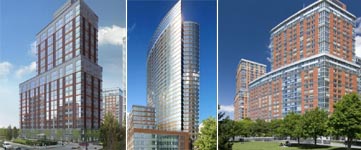Trending
Changes to LEED system set for debut
 |
Get ready for changes to Leadership in Energy and Environmental Design, the country’s most popular green building rating system. The new certification, known as LEED 2009, goes live next month and could be jarring for New York developers who have touted their buildings’ energy efficiency under the old system.
Newly built, LEED-certified buildings will have to submit electricity bills, said Doug Gatlin, vice president of market development at the U.S. Green Building Council, the system’s developer. This requirement will establish concrete data that a building is reaching LEED’s 14 percent efficiency benchmark, compared to baseline buildings, a requirement that was added in 2007.
Although buildings that have been certified under the old system, such as Battery Park’s Solaire and Verdesian, will retain their existing certifications and will not have to reapply. LEED 2009 will raise the point scale for qualification and standardize the rating system among different kinds of buildings.
Under the old system, buildings can gain up to a maximum of 69 possible points based on various environmental criteria and are ranked from “certified” to “platinum” by LEED accredited professionals, based on the number of points earned. The new system will raise the number of possible points to 100, Gatlin said.
LEED 2009, like the old system, will base its certifications on predicted energy use, determined in a computer model before an edifice is built.
“I don’t think that modeling and giving points is the way,” said architect Chris Benedict, who is among the critics of the system and who has built energy-efficient apartment buildings that are not LEED-certified. “There’s a fundamental argument going on in the building world — whether a model has any basis in reality…”
Gatlin noted that LEED addresses two different things, the design and construction of a building and its operation and maintenance. So while a building may be more energy efficient in theory, it won’t necessarily match its predicted energy usage if its day-to-day operations are wasteful.
“There’s actually research that shows that the management of a building is equally if not more important than the new technology in a buildings, ” Gatlin said.
Russell Albanese, president of the Albanese Corporation, developer of three green buildings in New York City, highlighted his buildings’ environmentally friendly features over their LEED certification.
“We weren’t even obligated to go for LEED,” he said. “We were trying to build a highly efficient green building.”
The Albanese Corporation developed the Verdesian at 211 North End Avenue, which opened in 2006, the first residential high-rise in the U.S. to be awarded platinum certification, and the Solaire at 20 River Terrace, one of the nation’s first green residential towers and gold certified under LEED.
Its new development is the Visionaire, a 251-unit Battery Park City condo at 70 Little West Street, which Albanese aims to make the “most sustainable residential high-rise in the country.” Amenities include an air filtration system, solar panels and a water treatment system, as well as use of natural gas and wind-generated power.
The Albanese Corporation has never disclosed its power bills, which will be required under the LEED 2009 system.
“I think that all LEED certified buildings should be happy to share their energy performance unless they’re not performing the way they should be. That means to me that they’ve lost a step in the process or their performance has eroded,” said Gatlin of the green building council. “It’s not too much for self-congratulations, but they owe it to the public in two or three years [to] say how the building is performing.”




